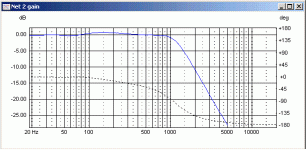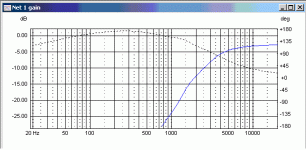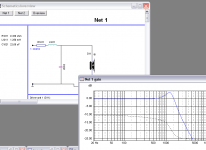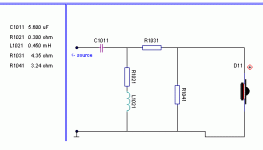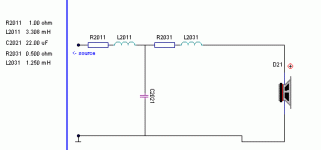Hiya Waltona, I can't really believe wilmslow would sell a design THEY think sounds pants so its well worth checking your xovers are what they should be.
I think the main problem is this: the 1.25mH coil leaves the upper end of the response about 2db above the lower end, IMO this sort of balance tilt tends to be mid-focused and lacking warmth. The bigger coil suggested flattens the woofer response, but of course everything else then needs changing to suit .
Poor cabs probably add colorations ( thickness, muddiness, obscuring of detail) rather than change tonal balance. However, reworking your crossovers may make what you think are cabinet problems magically go away😉 though cab quality should always be improved where possible.
Most designs with the 8545 use cab volumes around 15-22 litres, you could try reducing your volumes into this range ( dont forget to check the port freq!) with bricks or sand maybe.
I'd suggest www.audiocom-uk.com as an alternative to wilmslow for parts. Much better-and cheaper- inductors for a start.
I think the main problem is this: the 1.25mH coil leaves the upper end of the response about 2db above the lower end, IMO this sort of balance tilt tends to be mid-focused and lacking warmth. The bigger coil suggested flattens the woofer response, but of course everything else then needs changing to suit .
Poor cabs probably add colorations ( thickness, muddiness, obscuring of detail) rather than change tonal balance. However, reworking your crossovers may make what you think are cabinet problems magically go away😉 though cab quality should always be improved where possible.
Most designs with the 8545 use cab volumes around 15-22 litres, you could try reducing your volumes into this range ( dont forget to check the port freq!) with bricks or sand maybe.
I'd suggest www.audiocom-uk.com as an alternative to wilmslow for parts. Much better-and cheaper- inductors for a start.
Wilmslow seem to have used quite high-Q (peaky) slopes, and baffle step is not fully compensated, so I would guess these sound a little 'middy'. 33 litres is also a big box for these drivers; maybe bass is a bit bloated?
Peaky high Q slopes (electrically) are not a bad thing, IF they sum correctly to yeild a flat response whilst producing a good phase response.
It strikes me as being a little odd that the speakers dont blow away the dyns anyway. Im my experience even if baffle step is a little on the stingey side, if the speaker is good it will still sound excellent, its just that the tonal balance will be a little thin but by no means a bad sound.
Interesting I have just drawn up the schematics into LspCAD and used my measurements for a scan95, the hipass filters gain is actually not a high Q at all its a rather low Q network once combined with the tweeters impedance.
I also tried the woofer xover but I dont have measured impedance for the scan bass driver, so I used a peerless 850467.
Again the filter is not a low Q once combined with the drivers impedance. There is ZERO or maybe 1dB baffle step according to the filter gain, and I dont think the slightly different impedance of an 8545 is going to make much difference in the bass, the overall trend of the filter will still be apparent.
Here is the bass gain.
Attachments
I would suggest a complete redesign of the xover, but I doubt thats going to happen.
As an alternative I would build a simple PCB or even use vero board (ive had good results with active xovers using this) to make a baffle step compensation network and plug it between your preamp and power amp. Or your most used source and the amplifier.
The one listed on linkwitzlab.com is very easy to make and use, using just "text" book maths. Its also very easy to tweak if you use trimpots.
The only problem will be power for it, if you are confident with electronics then simply build a simple power supply or use batteries. You could also open up the amp and take power from the preamp section to feed the active xover.
If you dont want to do any of that then you could make a PLLXO (passive line level xover) for the same thing. This is no harder to make then an active xover but does require some knowledge of the amplifiers input impedance. But requires no power supply.
As an alternative I would build a simple PCB or even use vero board (ive had good results with active xovers using this) to make a baffle step compensation network and plug it between your preamp and power amp. Or your most used source and the amplifier.
The one listed on linkwitzlab.com is very easy to make and use, using just "text" book maths. Its also very easy to tweak if you use trimpots.
The only problem will be power for it, if you are confident with electronics then simply build a simple power supply or use batteries. You could also open up the amp and take power from the preamp section to feed the active xover.
If you dont want to do any of that then you could make a PLLXO (passive line level xover) for the same thing. This is no harder to make then an active xover but does require some knowledge of the amplifiers input impedance. But requires no power supply.
Just for comparison here is a filter gain for a speaker I have done with the 850467. This shows what baffle step comp actually looks like. This is slightly exaggerated because the 467 has a rising response which also has to be compensated for in the upper mid.
Attachments
Disabled Account
Joined 2003
Well, if worse comes to worse, you could pull out those drivers and do a complete rebuild in different cabinet and crossover.
Here's one already made for you:
http://home1.stofanet.dk/troels.gravesen/index_b/8545_9500.htm
OTOH, the low pass filter from Wilmslow is far from optimised.
a) does not tame the characteristic 800Hz bump and rising response of the 8545 drivers
http://www.d-s-t.com/link/scs/data/18w_8545-00c.htm
b) When you put any driver on a typical baffle it will show an relatively rising response, typically starting around 300-600Hz. This is because the low end will droop off (the "baffle step") Hence the need for baffle step compensation. Which that filter doesn't have.
Reduced or no baffle step compensation is ok, IF your speakers sit right up against a wall. But the speaker is going sound bright if you leave it free standing ie. baffle ~70-100cm from front wall.
c) actually causes a peak around 1.2Khz.
(Here's what lspCAD shows what that filter's doing)
After that I'd didn't bother with the high pass...
On a side note, 33L is that's little big for the 8545. It's no the "optimum" volume, but at least it's not primary problem. (33L is more ideal for TWO of those drivers.)
You can remedy (b) but putting your speakers closer to the wall, but iimaging will likely to suffer. But that leaves a) and c), which I suspect make the speaker sound like it's lacking depth, upper bass/lower midrange, (or relatively prominent midrange) are prolonged listening...
Here's one already made for you:
http://home1.stofanet.dk/troels.gravesen/index_b/8545_9500.htm
OTOH, the low pass filter from Wilmslow is far from optimised.
a) does not tame the characteristic 800Hz bump and rising response of the 8545 drivers
http://www.d-s-t.com/link/scs/data/18w_8545-00c.htm
b) When you put any driver on a typical baffle it will show an relatively rising response, typically starting around 300-600Hz. This is because the low end will droop off (the "baffle step") Hence the need for baffle step compensation. Which that filter doesn't have.
Reduced or no baffle step compensation is ok, IF your speakers sit right up against a wall. But the speaker is going sound bright if you leave it free standing ie. baffle ~70-100cm from front wall.
c) actually causes a peak around 1.2Khz.
(Here's what lspCAD shows what that filter's doing)
After that I'd didn't bother with the high pass...
On a side note, 33L is that's little big for the 8545. It's no the "optimum" volume, but at least it's not primary problem. (33L is more ideal for TWO of those drivers.)
You can remedy (b) but putting your speakers closer to the wall, but iimaging will likely to suffer. But that leaves a) and c), which I suspect make the speaker sound like it's lacking depth, upper bass/lower midrange, (or relatively prominent midrange) are prolonged listening...
Attachments
DId you import a real impedance for that filter to act upon?? my result was the same as yours until I added some real data.
If you just model the tweeters leg you can see you get a similar response, a peaky high Q filter. But if you add in the tweeters impedance data, as I have from my own measurements, the filters gain dramatically changes, as I have posted before. I have also posted the woofers filter gain but with another woofer its not as bad as you say it is.
If you just model the tweeters leg you can see you get a similar response, a peaky high Q filter. But if you add in the tweeters impedance data, as I have from my own measurements, the filters gain dramatically changes, as I have posted before. I have also posted the woofers filter gain but with another woofer its not as bad as you say it is.
tktran said:[
OTOH, the low pass filter from Wilmslow is far from optimised.
a) does not tame the characteristic 800Hz bump and rising response of the 8545 drivers
http://www.d-s-t.com/link/scs/data/18w_8545-00c.htm
b) When you put any driver on a typical baffle it will show an relatively rising response, typically starting around 300-600Hz. This is because the low end will droop off (the "baffle step") Hence the need for baffle step compensation. Which that filter doesn't have.
Reduced or no baffle step compensation is ok, IF your speakers sit right up against a wall. But the speaker is going sound bright if you leave it free standing ie. baffle ~70-100cm from front wall.
c) actually causes a peak around 1.2Khz.
(Here's what lspCAD shows what that filter's doing)
...
On a side note, 33L is that's little big for the 8545. It's no the "optimum" volume, but at least it's not primary problem. (33L is more ideal for TWO of those drivers.)
You can remedy (b) but putting your speakers closer to the wall, but iimaging will likely to suffer. But that leaves a) and c), which I suspect make the speaker sound like it's lacking depth, upper bass/lower midrange, (or relatively prominent midrange) are prolonged listening... [/B]
5th talks a lot of sense , BUT I agree entirely with the above quote.
The Wilmslow crossover with the 8545 DOES peak the response pretty much in line with the predicted transfer function - this is measurable and audible.
This seems to emphasise the problem caused by the c.800hz bump in the 8545's passband.
Has anyone got .FRD and .ZMA files for the 8545?
float said:
5th talks a lot of sense , BUT I agree entirely with the above quote.
The Wilmslow crossover with the 8545 DOES peak the response pretty much in line with the predicted transfer function - this is measurable and audible.
This seems to emphasise the problem caused by the c.800hz bump in the 8545's passband.
Has anyone got .FRD and .ZMA files for the 8545?
I agree with a) and b) in tktrans earlier post but not c.
Yes the filter does produce a hump at 1.2khz but not that bad when combined with a real impedance for a driver.
When I used my frequecy response data for the scan95 the filter dealt with the peak that the 95 produces at about 2khz but did leave a somewhat staggered effect that would require some extra output from the woofer to fill in the gap. It is possible here that the low xover between the drivers, coupled with a low Q tweeter roll off, is made flat with more output from the woofer around the xover frequency. So far I actually see nothing wrong with the wilmslow crossover appart from the severe lack of any bafflestep compensation
The 800hz bump is really not important, its what 2-3dB? I wouldnt even bother to compensate for this because the room would add or take away more then that to the overall sound anyway.
Adding the woofers slightly rising response to the network would produce a slightly prominant roll off on the 8545 but this may be needed coupled with the tweeter to give a flat response.
Using SPL trace with the scan 8545 graph gives a really ugly summation between the two. But then this is not to be trusted because scans own measurements of the 95 we off from my own.
Using my 95 data and scans 8545 there is a rising response in the trebble after a suckout at the xover region, this is not distructive interferance rather just a gap in the response between the drivers where no driver gives enough output.
I think for anything reliable with all of this we actually need to measure the speakers. All this is just speculation, yes we know how the filters are operating with regards to their electrical effect, but without good frequency response data we have nothing solid to go by.
The Q of the bass filter is higher with SPL trace and scans graphs then with my 467 data but not as bad as using flat impedance.
My recommendation stands at building a passive or active line level baffle step compensation network. Chances are wilmslow has done a good enough job on the xover. Unless you can get these to someone who can measure and redesign the xover for you, just stick with what you have got.
5th element said:
Unless you can get these to someone who can measure and redesign the xover for you, just stick with what you have got.
But where's the fun in that?😉
5th, you're right regarding the speculation, it would be great if Waltona could sort some measurements.
Any chance there's an SPL meter lurking in the cupboard?
float said:
But where's the fun in that?😉
5th, you're right regarding the speculation, it would be great if Waltona could sort some measurements.
Any chance there's an SPL meter lurking in the cupboard?
Ahh I see, the fun is however leaving the wilmslows alone and building a nice BSC circuit to make the sound nice again.
Right I decided to do the best I could with the data available to me and trying to maintain the wilmslow design the best I could but add BSC.
Basically I kept the filters gain exactly the same thru the xover region but altered the bass (lowered midrange) to yield around 5dB of baffle step comp. I also kept the tweeters gain exactly the same but just lowered the level by 5dB.
As its stands the tweeters network is exactly the same except for the L pad.
Attachments
Next is the bass xover. I managed to make this as cost effective as possible. You can use the 22uF caps and the 1.25mH inductors you already have, all you need to do for the whole change is purchase the two large inductors for the woofer xover and four resistors (maybe more to get the ohms right) for the tweeters.
This is very simple to do, replace the L pad and rewire the bass xover. Make sure to maintain the same polarity as the speakers already have, do not pay any attention to the polarity in the schematics I have posted. Dont worry too much about the DCR of the inductors either. Infact a larger R will alter the Q of the woofer slightly for the better if used in a larger box. Or in other words increasing the series resistance usually requires a slight increase in box volume.
This is very simple to do, replace the L pad and rewire the bass xover. Make sure to maintain the same polarity as the speakers already have, do not pay any attention to the polarity in the schematics I have posted. Dont worry too much about the DCR of the inductors either. Infact a larger R will alter the Q of the woofer slightly for the better if used in a larger box. Or in other words increasing the series resistance usually requires a slight increase in box volume.
Attachments
OK, my plan is to have a proper look at my cabinets to see what is really going on. If they look reasonably sound then I'll give 5th Elements crossover amendments a go. My wife is off on hols in a few weeks so I'll have a play then.
The transistion from mid/woofer to tweeter across the crossover, to my ears, sounds fine. No obvious peaks, change in sound at all. In that respect I'm quite happy with the Wilmslow crossover. Like I said previously, it is more a lack of mid-low/low end that is the problem.
I think rather than building an electronic BSC circuit I'd probably go for a complete cabinet/crossover rebuild with a trusted design (e.g. Troels). Sorry to be so unadventurous 5th.
@ 5th. Many thanks for your 'cost effective' help. Unfortunately, money is a factor so I greatly appreciate you taking this into account.
@float. SPL in the cupboard? You are joking I'm afraid. All I have is my ears and a test cd with a frequency sweep. 🙂
Thanks again to all.
The transistion from mid/woofer to tweeter across the crossover, to my ears, sounds fine. No obvious peaks, change in sound at all. In that respect I'm quite happy with the Wilmslow crossover. Like I said previously, it is more a lack of mid-low/low end that is the problem.
I think rather than building an electronic BSC circuit I'd probably go for a complete cabinet/crossover rebuild with a trusted design (e.g. Troels). Sorry to be so unadventurous 5th.
@ 5th. Many thanks for your 'cost effective' help. Unfortunately, money is a factor so I greatly appreciate you taking this into account.
@float. SPL in the cupboard? You are joking I'm afraid. All I have is my ears and a test cd with a frequency sweep. 🙂
Thanks again to all.
waltona said:OK, my plan is to have a proper look at my cabinets to see what is really going on. If they look reasonably sound then I'll give 5th Elements crossover amendments a go. My wife is off on hols in a few weeks so I'll have a play then.
The transistion from mid/woofer to tweeter across the crossover, to my ears, sounds fine. No obvious peaks, change in sound at all. In that respect I'm quite happy with the Wilmslow crossover. Like I said previously, it is more a lack of mid-low/low end that is the problem.
I think rather than building an electronic BSC circuit I'd probably go for a complete cabinet/crossover rebuild with a trusted design (e.g. Troels). Sorry to be so unadventurous 5th.
@ 5th. Many thanks for your 'cost effective' help. Unfortunately, money is a factor so I greatly appreciate you taking this into account.
@float. SPL in the cupboard? You are joking I'm afraid. All I have is my ears and a test cd with a frequency sweep. 🙂
Thanks again to all.
All I can say is that without measurements I cannot guarantee anything, but there is nothing I can think of at this moment which would indicate why this wouldnt work. Good luck.
Matt
waltona said:
The transistion from mid/woofer to tweeter across the crossover, to my ears, sounds fine. No obvious peaks, change in sound at all. In that respect I'm quite happy with the Wilmslow crossover. Like I said previously, it is more a lack of mid-low/low end that is the problem.
I think rather than building an electronic BSC circuit I'd probably go for a complete cabinet/crossover rebuild with a trusted design (e.g. Troels). Sorry to be so unadventurous 5th.
If you can borrow a 31-band graphic eq or somesuch and boost the bands from 160 to 500hz by 3 or4 db you'll get an idea what correcting BSC will do for you.
I'm sure you wouldn't have to search to hard to find designs using these drivers on the web or even this site.
5th, can you say what you modelled your suggested xover with?
Based on my fun and games with the 8545 this seems like a lot of inductance.
May I also venture that 3rd order filters are harder to get right first time?
Like the money saving angle tho.😀
float said:
If you can borrow a 31-band graphic eq or somesuch and boost the bands from 160 to 500hz by 3 or4 db you'll get an idea what correcting BSC will do for you.
I'm sure you wouldn't have to search to hard to find designs using these drivers on the web or even this site.
5th, can you say what you modelled your suggested xover with?
Based on my fun and games with the 8545 this seems like a lot of inductance.
May I also venture that 3rd order filters are harder to get right first time?
Like the money saving angle tho.😀
Eugh you asked for it ok how to explain.
Okedoke I applied the filters wilmslow provided onto the measurements I have taken for the scan95 and onto the SPL trace frd, zma's created from scan speaks measurement for the 8545.
Then I exported the overall SPL for each driver after the wilmslow crossover had been added to it. This now shows me the effect of the xovers and gives me a target to aim for.
I then re imported those exported SPL's and used them as targets. For the tweeter network I simply lowered the imported SPL by 5dB and then changed the Lpad to match. This means that tha altered filter does exactly as it does in waltonas speakers but at just 5dB lower.
For the midbass xover I fiddled around a bit and found out that I needed a large inductor to decrease the midrange suffciently. Then I also needed a second inductor to shape the upper ends response to mach the original exported graph.
So to sum it up, I did the same for the midbass as I did for the tweeters but only thru the upper end of its range. Eg - I lowered the upper end by 5dB and matched the roll off the best I could thus keeping the roll off at xover exactly the same as the wilmslow but lowering it gradually by 5dB.
Even though this doesnt use "real" data I know what the wilmslow filters are doing, aslong as my filters match that in the important areas it should be OK.
A year or so back, I visited Wilmslow to listen to their new small speakers. They were dissapointing.
As a point of comparison (thinking they might be vaguely similar to my Proac R2.5 clones) I had a listen to the Vogues (with 9300). I thought they were pretty good with a full and quite musical bass, they did not seem to lack BSC, at about 1ft from the wall).
I agree the XO looks a bit primitive and the box size is theoretically a bit too big, but they were most enjoyable listen and hugely superior to the little boxes with Excell drivers they are now pushing.
My recommendation is to make sure they are standard.
Don't bother with Troel's XO (if my experience with his R2.5 XO is anything to go by).
What equipment does your brother use? The vogues should sound OK on budget Arcam stuff - which is normally fairly warm sounding - but they are good enough to benefit from quality kit.
As a point of comparison (thinking they might be vaguely similar to my Proac R2.5 clones) I had a listen to the Vogues (with 9300). I thought they were pretty good with a full and quite musical bass, they did not seem to lack BSC, at about 1ft from the wall).
I agree the XO looks a bit primitive and the box size is theoretically a bit too big, but they were most enjoyable listen and hugely superior to the little boxes with Excell drivers they are now pushing.
My recommendation is to make sure they are standard.
Don't bother with Troel's XO (if my experience with his R2.5 XO is anything to go by).
What equipment does your brother use? The vogues should sound OK on budget Arcam stuff - which is normally fairly warm sounding - but they are good enough to benefit from quality kit.
Thanks 5th, now it makes more sense.
TBH I've been thinking the wilmslow peaking filter is screwy and I'd mentally discarded it, so your remodelling also seemed weird.
I do still reckon he only needs about 3db more baffle step, rather than full correction🙂
I'll try to find/create 8545 frd and zma files and have a play myself
All the best
TBH I've been thinking the wilmslow peaking filter is screwy and I'd mentally discarded it, so your remodelling also seemed weird.
I do still reckon he only needs about 3db more baffle step, rather than full correction🙂
I'll try to find/create 8545 frd and zma files and have a play myself

All the best
Dave S said:..........
As a point of comparison (thinking they might be vaguely similar to my Proac R2.5 clones) I had a listen to the Vogues (with 9300). I thought they were pretty good with a full and quite musical bass, they did not seem to lack BSC, at about 1ft from the wall).
I agree the XO looks a bit primitive and the box size is theoretically a bit too big, but they were most enjoyable listen and hugely superior to the little boxes with Excell drivers they are now pushing.
My recommendation is to make sure they are standard.
......................
This concours with my experience and earlier recomendation.
Errors in the amplitude-response of a speaker tend to be benign with respect to those in the time domain. Time domain errors tend to rob a speaker of musicallity. Here's a Stereophile review of the Reference 3a de capo i, review a $2500 speaker with considerably bigger amplitude-response errors than the Wilmslow unit, but considered very musical.
Correcting a speakers amplitude-response errors tends to interfere with the time domain, hence my reccomendation to get back the the original setup. Here's a DIY audio post by one of the Wilmslow desiners (user pxr5, possibly the designer of your speaker), about speaker mucicality, the thread is about active vs passive X-overs, but the post is valid to this thread IMO. It eplain how the Wilmslow designer has searched for a good sound, with active X-overs, etc but found none better than a simple passive X-over.
This concours with my experience and earlier recomendation.
Absolutely!
QUOTE]Correcting a speakers amplitude-response errors tends to interfere with the time domain[/QUOTE]
Not sure about this statement although in the case of the Proacs, Troels tried to remove the peaks and ended up ruining the speaker. OTOH my CAOW1s have quite flat amplitude (and power) response and easily show what is wrong with the Proacs.
FWIW, I reckon the Vogue is better than the Proac R2.5 (although I heard them in different rooms/systems).
Also FWIW, despite some major benefits, I have never been completely happy with active systems.
- Status
- Not open for further replies.
- Home
- Loudspeakers
- Multi-Way
- Why don't my Wilmslows sing?
